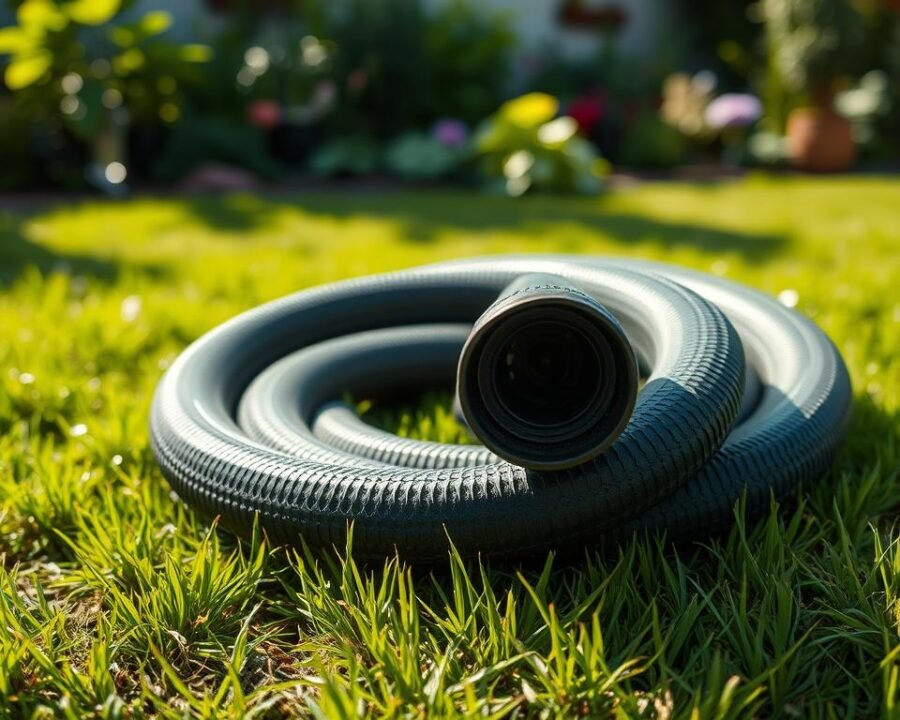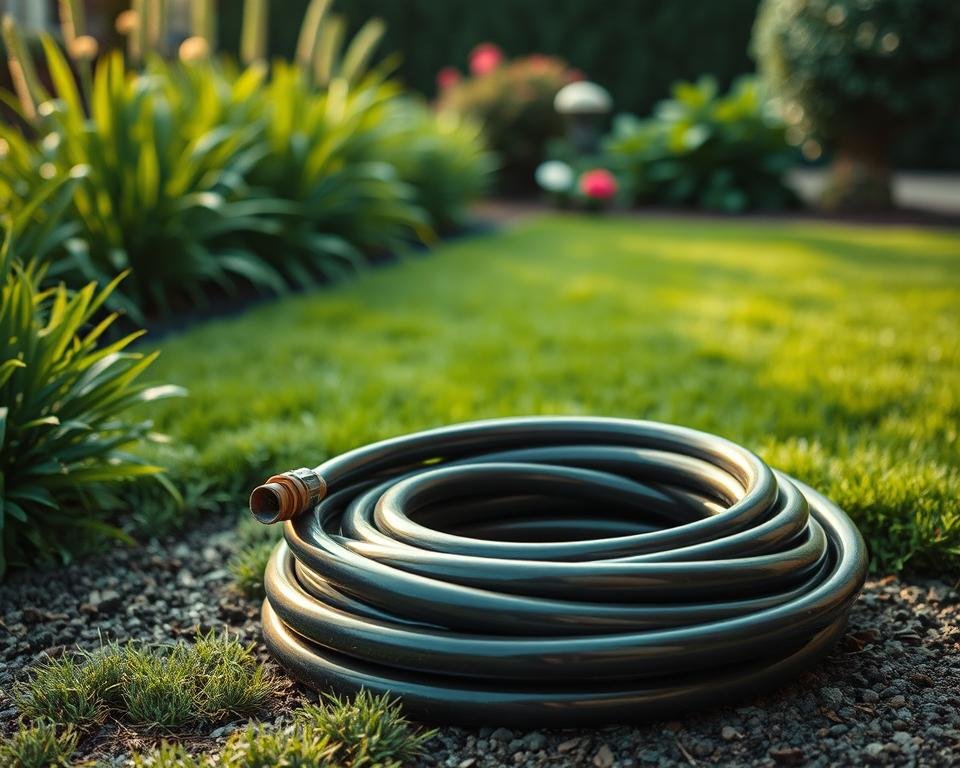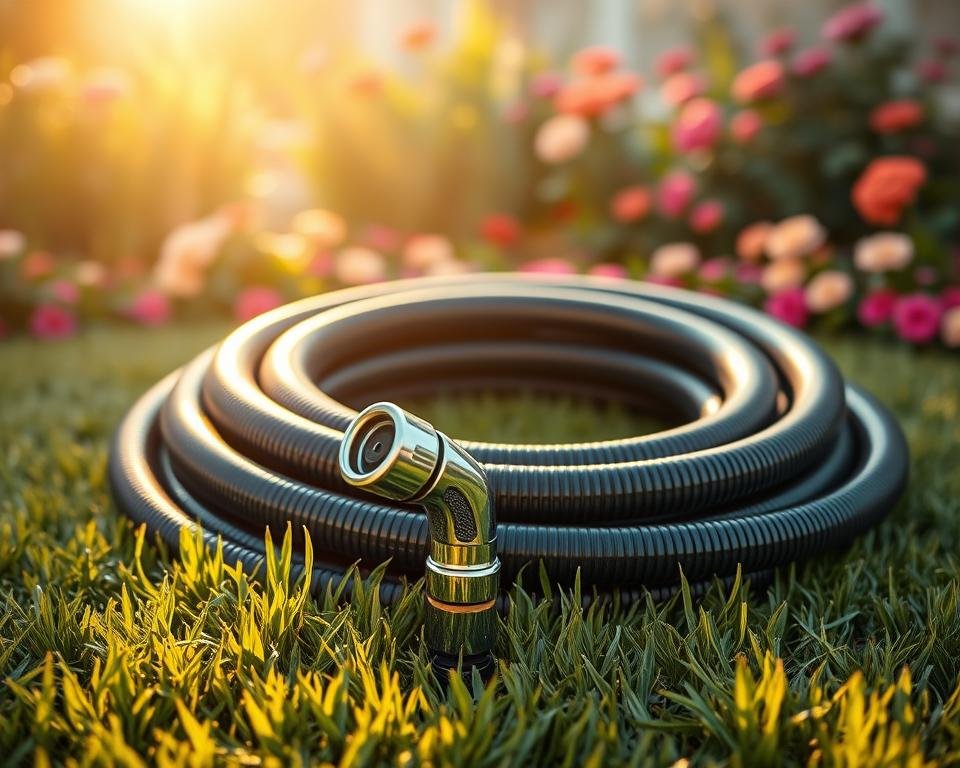Finding the best garden hose is key for any yard. It’s vital for keeping your lawn and garden looking great. A good hose is the backbone of any yard.
Choosing the right 1 inch garden hose can be tough. We’ve tested many hoses in our lab and at home. We want to help you find the perfect hose for your yard.
Having the right hose is essential for a beautiful yard. In this article, we’ll talk about why a good hose matters. We’ll also cover materials, key features, and more.
Key Takeaways
- Understand the importance of a good garden hose for yard maintenance.
- Learn about common materials used in garden hoses.
- Discover key features to look for in a garden hose.
- Find out how to choose the best garden hose for your yard.
- Get insights into the different types of garden hoses available.
Understanding the Importance of a Good Garden Hose
A good garden hose is key for any gardening project. It keeps your plants healthy and growing. A durable and efficient hose is what you need for your garden.
Our guide on selecting and buying a garden water hose is very important. It helps you choose the right one for your garden.

Benefits of Using a High-Quality Hose
A heavy duty garden hose or a durable garden hose has many benefits. It can handle frequent use and harsh weather. This means you can garden without worrying about a broken hose.
Also, a top-notch hose gives you steady water pressure. This is crucial for watering your plants evenly. A gardening expert says, “A good garden hose makes your job easier and more efficient.”
“A garden hose is not just a simple tool; it’s a lifeline for your garden.”
The Role of Hose Diameter in Performance
The hose’s diameter is very important. A bigger diameter hose can carry more water. This is great for large gardens or big water tasks like washing cars.
A high pressure garden hose with the right diameter saves time and boosts efficiency. Pick a hose diameter that fits your watering needs.
Think about your yard’s size and your gardening tasks when choosing a hose. A hose that’s too small may not have enough pressure. A hose that’s too big can be hard to handle.
Common Materials Used in Garden Hoses
Garden hoses come in various materials, each with its own benefits and drawbacks. Knowing these differences helps you choose the right hose for your needs.

Rubber vs. Vinyl: Which Is Better?
Rubber hoses are tough and can handle extreme temperatures. They’re heavier and pricier but last longer. Vinyl hoses are lighter and bendier, making them easier to move around. Yet, they might not last as long as rubber and can kink more easily.
Think about what you need. Rubber hoses are great for those who want something durable and can handle a heavier hose. Vinyl hoses are better for those who want something lighter and more flexible.
Pros and Cons of Reinforced Hoses
Reinforced hoses are stronger and less likely to kink. They mix materials like rubber, vinyl, and polyurethane. The added layers or fibers help prevent damage.
Reinforced hoses are more durable and less prone to damage. But, they’re heavier and cost more. Decide if the extra features are worth the extra cost for your gardening needs.
For more info on garden hoses, check out our article on different types of garden hoses.
Key Features to Look for in a Garden Hose
A good garden hose is more than just a simple watering tool; it’s an essential part of your gardening arsenal. When picking a garden hose, there are key features to look at to find the right one for you.
Length Options: Finding the Right Size for Your Yard
The length of your garden hose is very important. It decides how easily you can water your plants without being limited by the hose’s reach. A long garden hose is great for bigger yards, letting you water plants without moving the hose’s source often.
For most homes, a hose length of 50 to 100 feet works well. But, if your yard is bigger or you water from a central spot, you might need a longer hose. Also, think about a hose that doesn’t kink to avoid water flow problems.
Fittings and Connectors: Ensuring Compatibility
The fittings and connectors on your garden hose are just as crucial as its length. A 1 inch garden hose is a favorite among gardeners because it balances water flow and pressure well. Make sure the hose’s fittings and connectors match your current watering tools and accessories.
Choose hoses with durable, rust-resistant fittings that can handle regular use. Some hoses have quick-connect features, making it simpler to switch between different attachments or tools. Checking compatibility saves time and hassle in the long run.
How to Choose the Right 1 in Garden Hose
Choosing the best garden hose for your yard is about understanding your watering needs. It’s also about knowing what features are most important. You need to look at several key factors that affect how well the hose works and how easy it is to use.
Assessing Your Watering Needs
To pick the right garden hose, first think about your watering needs. Look at the size of your yard and the types of plants you have. Also, consider how often you water them. For bigger yards or gardens with many plants, a heavy-duty garden hose might be needed to get enough water.
- Measure the distance from your water source to the farthest point in your yard to determine the required hose length.
- Consider the water pressure in your area, as it affects the hose’s performance and durability.
- Think about the types of plants you have; some may require more water than others.
Considering Hose Weight and Flexibility
The weight and flexibility of a garden hose are very important. A hose that’s too heavy or stiff can be hard to move, especially in big yards or for people with mobility issues.
We tested different hoses to see how they performed. We found that a hose that’s both durable and flexible is best for most people.

When picking a garden hose, balance what you need with what different hoses offer. Think about your watering needs and the hose’s weight and flexibility. This way, you can find a hose that works well and is easy to use.
Maintenance Tips for Longevity
Proper care and storage of your garden hose can make it last longer. A well-maintained durable garden hose is less likely to get damaged. It will keep on providing efficient watering for your garden.
To keep your hose in good shape, follow some easy maintenance tips. Always store your hose on a reel or in a dry spot to avoid damage and kinking. This is especially true for a kink resistant hose, as it can still get kinked if not stored right.
Proper Storage Practices
Storing your garden hose correctly is key to its longevity. Here are some best practices to follow:
- Always drain the hose before storing it to prevent water from freezing and causing damage.
- Use a hose reel to keep the hose organized and prevent kinking.
- Store the hose in a dry location, away from direct sunlight and extreme temperatures.
Cleaning Your Hose Effectively
Regular cleaning is also vital for maintaining your garden hose. Here are some tips to keep your hose clean and functional:
| Cleaning Method | Benefits |
|---|---|
| Use mild soap and water to clean the hose | Removes dirt and debris, preventing damage and maintaining water flow |
| Avoid using harsh chemicals or abrasive materials | Prevents damage to the hose material and maintains its durability |
By following these simple maintenance tips, you can make your durable garden hose last longer. It will keep on providing efficient watering for your garden.

Troubleshooting Common Hose Issues
Fixing common hose problems is key to a healthy garden. Hoses can get kinked, knotted, or leak, even with good care.
Dealing with Kinks and Knots
A kink or knot in your hose can be annoying, especially when watering. Use a kink resistant hose to avoid twisting and bending issues. If a kink happens, try to straighten it and check for blockages.
Regularly check your hose for wear and damage. This can help prevent kinks and knots.
Fixing Leaks and Drips
Leaks and drips waste water and lower watering efficiency. To fix a leak, look for damaged spots and replace them if needed. A high pressure garden hose can also help by handling water pressure better.
Always check for leaks and fix them quickly. This saves water and ensures your plants get enough moisture.
| Issue | Cause | Solution |
|---|---|---|
| Kinks | Twisting or bending of the hose | Use a kink resistant hose, straighten the hose |
| Leaks | Damaged or worn-out areas | Inspect and replace damaged sections, use a high pressure garden hose |
Eco-Friendly Garden Hoses: What to Consider
As we focus on making our gardens greener, we must think about our hoses. The way we make, use, and throw away hoses affects our planet. It’s about using less and wasting less.
Some hoses are made from materials like recycled rubber or polyurethane. These choices help our gardens be kinder to the Earth. We also found hoses that save water, like soaker hoses and timers, which cut down on water use.
Benefits of Using Recycled Materials
Using recycled materials in hoses saves natural resources and cuts down on waste. For example, recycled rubber hoses use rubber that would otherwise go to landfills. This makes hose production better for the planet and supports a closed-loop economy.
Key benefits of recycled hoses include:
- Reduced demand for virgin raw materials
- Minimized waste generation
- Lower environmental impact
Water Conservation Features
Some hoses are made to save water. Soaker hoses, for instance, water plants right at the roots, cutting down on evaporation and runoff. Hoses with timers help avoid too much watering, making sure plants get just the right amount of moisture.
Choosing eco-friendly hoses lets gardeners do their part for the planet. Whether it’s recycled materials or designs that save water, smart hose choices make gardening better for the Earth.
Top Brands for 1 in Garden Hoses
The quality of a garden hose shows the maker’s reputation. Many brands are out there, but some stand out for their quality and performance.
A Look at Leading Manufacturers
We looked into top garden hose brands like Eley, Dramm, and Flexzilla. These brands are known for making high-quality hoses for garden lovers.
Eley is famous for its tough and kink-free hoses. Dramm has hoses with top-notch fittings and connectors. Flexzilla offers hoses that are flexible and light, making them easy to handle.
Comparing Customer Reviews and Ratings
We checked out what customers say about these brands. They all got great reviews for their hoses. People love their durability, flexibility, and how well they work.
When picking a garden hose, think about the brand’s reputation and what others say. This way, you’ll get a hose that’s right for your garden.
Look at reviews for durability, ease of use, and value. This helps you choose the best garden hose for your yard.
Price Range Analysis
The price of garden hoses varies based on material, length, and features. A durable garden hose can cost anywhere from under $20 to over $100.
When looking at a 1 inch garden hose, know what you’re getting. Cheaper hoses might use lower-quality materials. This could impact their durability and how well they work.
Understanding What You’re Paying For
The cost of a hose often shows its quality and features. More expensive hoses use better materials like kink-resistant rubber or reinforced PVC. These materials can make the hose last longer and work better.
Premium hoses also have extra features like leak-proof connections and UV resistance. These add to the hose’s value and make it easier to use.
Budget vs. Premium Options: Is It Worth It?
Choosing between a cheap and a pricey 1 inch garden hose depends on your needs. If you just garden now and then, a cheaper hose might be okay. But if you garden a lot, a better hose is worth the extra cost.
By looking at prices and what you get, you can choose wisely. This way, you find a hose that fits your needs and budget.
Seasonal Care for Your Garden Hose
To keep your garden hose in top shape, adjust your care routine with the seasons. Proper care can make your long garden hose last longer and work better.
Winterizing Your Hose
Winterizing your garden hose is key to avoiding damage from cold. Start by disconnecting it from the outdoor faucet and draining it fully. This stops water from freezing inside, which can cause damage.
For more tips on winterizing, check out our guide on how to winterize your garden hose.
After draining, store your hose in a safe place like a garage or shed. This protects it from harsh winter weather. If you live where it gets very cold, use a kink resistant hose made for freezing temperatures.
Preparing for Summer Usage
When summer comes, check your hose for winter damage. Look for cracks, leaks, or kinks and replace it if needed. A good hose is key to a healthy garden in the summer.
Before using your hose again, test it under pressure. This helps find any problems early. It ensures your long garden hose is ready for summer watering.
Where to Buy the Best Garden Hose Online
Looking for a top-notch garden hose online involves several considerations. We’ve looked into the best places to buy, like Amazon and Home Depot. These sites have a wide selection of hoses from different brands. This makes it simple to compare prices and features.
Trusted Retailers for Quality Hoses
Amazon and Home Depot are known for their quality garden hoses. They offer detailed descriptions, customer feedback, and good prices. This helps you choose the right hose for your garden.
Comparing Prices and Convenience
It’s key to compare prices when buying a hose online. We’ve looked at shipping costs, customer service, and return policies. This ensures you get the best deal without any trouble.
By keeping these points in mind and shopping at trusted sites, you’ll find the perfect hose. It will meet your watering needs and last a long time.
FAQ
What is the ideal diameter for a garden hose?
The right diameter for a garden hose depends on your needs. A 1 inch hose is often chosen. It balances water pressure and flexibility well.
What are the most common materials used in garden hoses?
Garden hoses are usually made from rubber, vinyl, or reinforced materials. Rubber hoses are tough. Vinyl hoses are lighter and more flexible. Reinforced hoses are stronger and less likely to kink.
How do I choose the right length for my garden hose?
Think about your yard’s size and the distance to water sources. A longer hose is convenient but can be heavy and kink easily.
What are the benefits of using a heavy-duty garden hose?
Heavy-duty hoses are made for frequent use and harsh weather. They’re thicker, more durable, and less likely to leak or kink.
How do I maintain my garden hose to extend its lifespan?
Store your hose on a reel or in a dry place. Clean it often to avoid dirt buildup. Check for wear and tear regularly.
What are some common issues with garden hoses, and how can I troubleshoot them?
Issues like kinking and leaking are common. Try straightening the hose or using a kink-resistant design. Tighten any loose parts to fix leaks.
Are there any eco-friendly garden hoses available?
Yes, eco-friendly hoses are made from recycled materials or designed to save water. They help reduce waste and conserve water.
How do I choose a reliable brand for my garden hose?
Look at product quality, customer service, and satisfaction. Choose brands known for durable, high-quality hoses.
What is the price range for a good garden hose?
Prices vary based on material, length, and brand. You can find affordable options or premium hoses with extra features.
How do I winterize my garden hose to prevent damage?
Drain the hose fully and store it in a dry, protected spot. This prevents freezing and damage.
Where can I buy a high-quality garden hose online?
Buy online from trusted retailers that offer durable, kink-resistant hoses. Compare prices and consider shipping and service.
